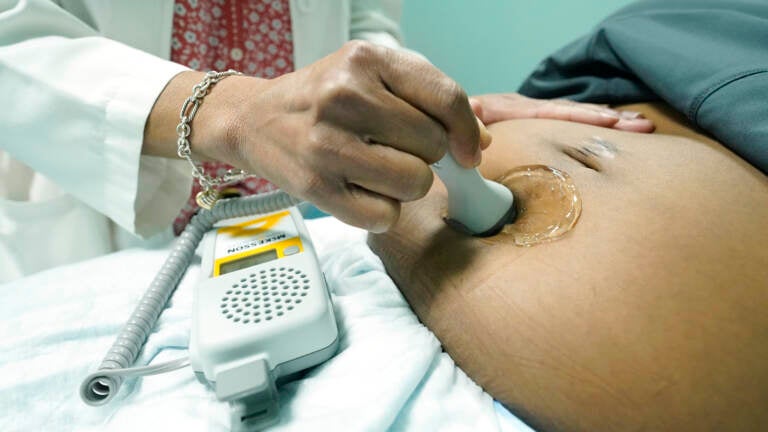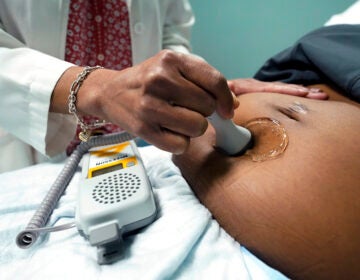U.S. maternal mortality rates ‘not as bad as previously thought’ says Rutgers epidemiologist, researchers in new study
Researchers found a much lower mortality rate — 10.4 deaths per every 100,000 births — after investigating data collected by the CDC.
Listen 1:15
File photo: A midwife at Sisters in Birth, a Jackson, Miss., clinic that serves pregnant women, uses a hand-held doppler probe on a patient from Yazoo City to measure the heartbeat of her fetus in 2021. (Rogelio V. Solis/AP)
From Philly and the Pa. suburbs to South Jersey and Delaware, what would you like WHYY News to cover? Let us know!
The United States has become known for having the worst rate of maternal mortality among high-income nations globally, according to data published by the Centers for Disease Control and Prevention.
The federal agency estimates that there are 32.9 deaths per every 100,000 live births as of 2021, a figure that has steeply climbed in recent years.
But a group of researchers began to question that data and wondered, how does the country that spends the most on health care per person have some of the poorest maternal and pregnancy outcomes in the world?
After analyzing and reviewing maternal mortality data reported to the CDC’s National Center for Health Statistics, the researchers came to a different conclusion.
“Maternal mortality is not as bad as previously thought,” said Cande Ananth, chief of the Division of Epidemiology and Biostatistics in the Department of Obstetrics, Gynecology, and Reproductive Sciences at Rutgers Robert Wood Johnson Medical School.
Ananth and his research partners published their findings this month in the American Journal of Obstetrics and Gynecology. Their study found a current U.S. maternal mortality rate of 10.4 deaths per every 100,000 live births, which would bring it more in line with incidence in countries like Canada and France.
“Still it’s a problem, don’t get me wrong, but the rates are substantially lower,” he said. “We actually see very stable rates, and the revised maternal mortality data in the U.S. is actually very well within range of every developed nation.”
When tracked by the CDC, maternal deaths are defined as deaths that happen during pregnancy, childbirth and in the immediate postpartum period. They can happen from direct obstetric causes like severe bleeding, uterine rupture and infections, and indirect causes from underlying health conditions like cardiovascular problems, mental health issues, diabetes and high blood pressure.
The Rutgers researchers used a more narrow algorithm for calculating maternal deaths and did not include mental health conditions broadly as qualifying underlying conditions.
“Now, we are not claiming that mental health conditions do not contribute to maternal mortality,” Ananth said. “There are certain mental health conditions that definitely should be included as part of the maternal mortality capture. We’re not sure what those conditions are.”
The team also didn’t include deaths that were traced back to accidental injuries or causes unrelated to a person’s pregnancy or labor. They also excluded cases where the pregnancy-related checkbox on a person’s death certificate was erroneously marked, especially when that person was significantly older than reproductive age or had died from a co-occurring disease like cancer.
The new study found that improvements in obstetrical care have led to fewer direct-cause maternal deaths over time, but worsening underlying health causes have offset those gains and kept death rates from improving.
These outcomes are still considered rare — 1,205 women in the U.S. died of maternal causes in 2021 out of 3.6 million live births that year.
But public health experts say these figures are still too high compared to countries like Japan, Australia and Switzerland, which recorded fewer than 3 deaths per every 100,000 live births in 2020, according to global data.
State and local maternal mortality review boards have found that a majority of maternal deaths are preventable.
“There should be no deaths, period,” Ananth said. “The process of pregnancy, the process of procreation, has been in place for millions of millions of years. We have come so far in advancements and we should not be encountering maternal deaths.”
While the new study found lower maternal mortality rates across the board, racial disparities remained.
Black women account for a disproportionate number of annual deaths, according to the CDC. This was also reflected in the new study, which showed Black women died at 2.5 to 3 times the rate of white women.
“We really haven’t done much to minimize or close that race gap in maternal mortality statistics,” Ananth said.
In a statement to NPR, the CDC disagreed with the study’s findings and argued that it substantially undercounts maternal deaths.
Leaders of the American College of Obstetrics and Gynecology and the March of Dimes have released statements criticizing the study.
Dr. Christopher Zahn, ACOG interim CEO, said the publication “paints an incomplete picture” of maternal mortality rates and “minimizes the many lives lost and the families that have been deeply affected.”
March of Dimes president and CEO Dr. Elizabeth Cherot recognized the challenge of accurately measuring maternal deaths and said she was concerned that by classifying the CDC’s mortality rates as an overestimation, “We overlook the dangers facing our nation’s moms, especially Black moms.”
The study’s authors said their investigation of maternal mortality rates was not meant to diminish attention on a serious public health problem, but rather provide accurate data used to inform targeted interventions and solutions.

Get daily updates from WHYY News!
WHYY is your source for fact-based, in-depth journalism and information. As a nonprofit organization, we rely on financial support from readers like you. Please give today.






